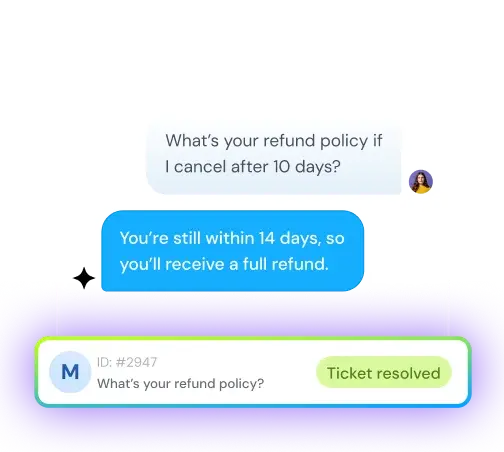Building better customer service chatbots: Lessons, tools, and fixes
Sneha Arunachalam
Nov 03, 2025
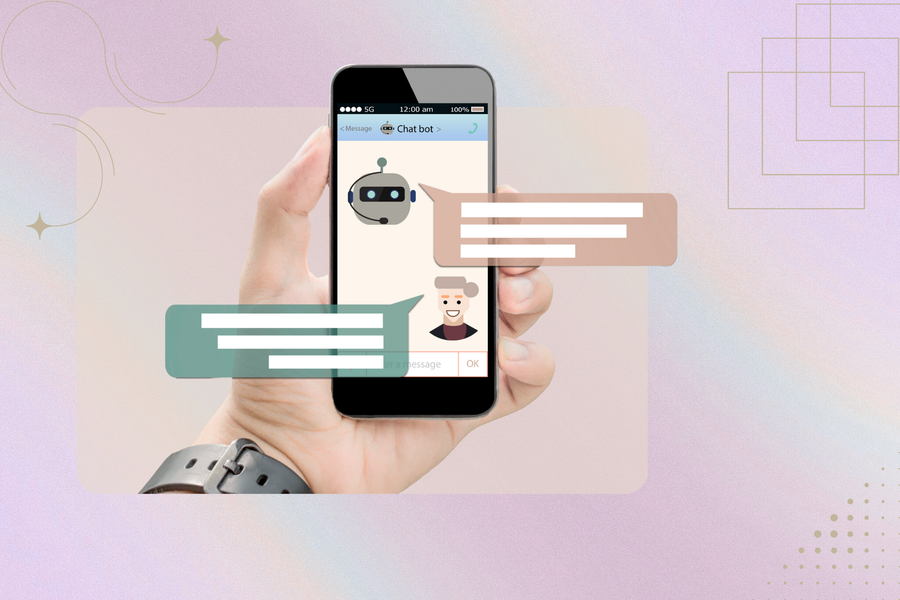
“Hi! How can I help you today?”
It’s a line we’ve all seen pop up in the corner of a website often before we’ve even clicked anything.
But here’s the twist: it’s not a person saying it. It’s a customer service chatbot and it’s quietly transforming how companies handle support.
Whether you're ordering food, tracking a package, or troubleshooting your Wi-Fi, chances are you've chatted with a bot. And if it worked well, you probably didn’t even realize it.
But with AI evolving faster than ever, the big question isn’t whether chatbots can handle customer service it’s whether they should.
Are they the future of fast, scalable support? Or just another short-lived tech trend businesses are rushing to adopt?
Let’s dig in.
What is a customer service chatbot?
Most people still think of chatbots as those annoying pop-ups that can't help with anything real. But customer service chatbots have come a long way. They're automated programs that actually hold conversations with your customers, using AI and natural language processing to understand what people are asking — whether through text or voice.
Definition and core purpose
Think of it like this: a customer service chatbot is your digital front desk person who never takes a break. These AI-powered helpers answer questions, walk people through purchases, and even suggest products based on what customers actually want.
The whole point? Give customers instant help without making them wait for a human agent. These bots work across your website, messaging apps, and social media — so customers get consistent support no matter where they reach out.
Types of customer service chatbots
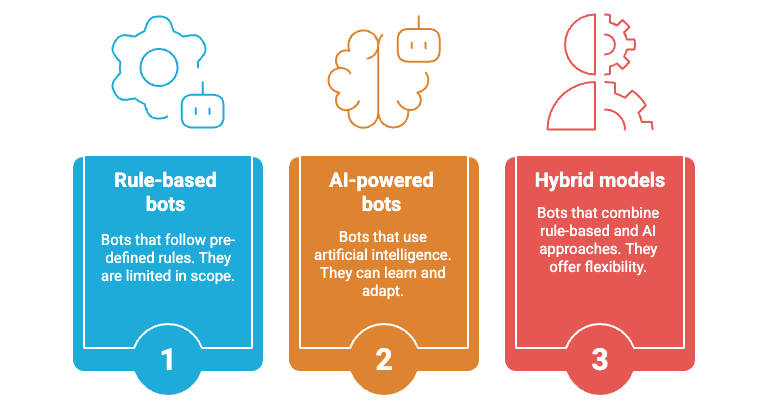
Let's be honest — not all chatbots are created equal. Picking the wrong type can leave your customers frustrated and your team scrambling to fix conversations that went sideways.
Rule-based bots
Rule-based chatbots work like those old "choose your own adventure" books. They follow predetermined "if-then" paths, responding based on specific keywords and patterns they've been taught to recognize.
These bots shine when handling straightforward, predictable stuff. They'll answer your most common questions, walk users through simple processes, and collect basic info without breaking a sweat. Since they stick to their programmed rules, you get consistent responses every single time.
You'll see rule-based bots in a few different flavors:
- Button-based bots that give customers clickable options
- Keyword recognition bots that pick up on specific terms
- Decision-tree bots that narrow things down based on user choices
Here's why smaller businesses love them — they're quick to set up, cost way less upfront, and play nice with your existing systems. Perfect if you've got clear support goals or just want a solid FAQ resource.
But here's the catch: these bots can't think outside their programming. Ask a question in a slightly different way, and they're lost. As one source puts it, "They cannot answer any questions outside the defined rules" and "do not learn through interactions".
AI-powered bots
AI-powered chatbots are the smart cookies of the bunch. Instead of just hunting for keywords, they actually understand what customers mean — even when they phrase things weirdly.
The real magic happens over time. Each conversation teaches them something new, so they keep getting better at understanding patterns and context. These bots can:
- Handle natural, conversational language
- Remember what you talked about before
- Pick up on emotions and sentiment
- Learn from every interaction to improve next time
This makes AI bots perfect for handling those curveball questions that would stump a rule-based system. They'll ask follow-up questions when they need clarity and give personalized answers based on customer history.
The trade-off? You're looking at more time and money to get them running properly. They need tons of training data to work well, so they're better suited for companies with bigger support volumes and more varied customer needs.
Hybrid models
Hybrid chatbots give you the best of both worlds — the reliability of rule-based systems plus the smarts of AI. They handle simple stuff through predetermined rules but switch to AI mode when conversations get complex.
"Hybrid chatbots combine the strengths of both rule-based and AI-driven systems," notes one industry source. This dual approach creates a smoother customer experience without sacrificing consistency.
Here's what makes hybrid models so appealing:
- Rock-solid handling of everyday questions
- AI kicks in for the tricky stuff
- Smooth handoffs to human agents when needed
- Personalized responses based on user history
- Gets smarter through machine learning
These bots remember your conversations and use that context to make future chats more helpful. Pair that with automation features, and customers can actually get things done — like placing orders or checking shipping status — without needing human help.
For growing businesses, hybrid models hit that sweet spot between immediate results and long-term potential. Sure, they take more work to set up than basic rule-based systems, but they scale better and handle more sophisticated customer interactions as your business grows.
Common use cases in support
Customer service chatbots really shine in these areas:
Answering FAQs and common questions: Bots pull answers from your knowledge base instantly, taking pressure off your human team.
Order confirmation and shipping tracking: Nobody wants to dig through complicated menus to check their order status. Bots make this simple with instant updates.
Collecting customer feedback: Instead of boring surveys, bots can gather opinions through natural conversations.
Password resets and account assistance: Perfect for those "I forgot my password" moments that happen at 2 AM.
Multilingual support: Modern bots speak over 100 languages, so customers can get help in whatever language feels comfortable.
Bottom line — chatbots handle the repetitive stuff so your human agents can focus on the complex problems that actually need a personal touch.
6 Benefits of chatbots for customer service

Look — most businesses don't just throw money at chatbots for fun. They're seeing real returns that actually matter to their bottom line. These digital helpers deliver value in ways that make your support team's life easier and your customers way happier.
1. 24/7 availability
Here's something your human agents can't do — work through the night without coffee breaks. Customer service chatbots handle inquiries during those 3 AM moments when someone desperately needs help. No more "Sorry, we're closed" messages that send frustrated customers straight to your competitors. This round-the-clock availability creates that seamless support experience customers have come to expect.
2. Reduced support costs
Customer service chatbots are like extra hands on your support team—but without the extra salary. They handle routine questions (like “Where’s my order?” or “How do I reset my password?”) so your human agents can focus on the stuff that actually needs a real person. Over time, this means fewer support tickets, smaller teams, and lower overhead—all without compromising service quality
3. Faster response times
Nobody likes waiting around for answers. Customer service bots deliver instant responses while your customers are still typing their questions. They can:
- Handle multiple conversations at once
- Skip the "let me think about that" pause
- Connect people with solutions in seconds, not minutes
This speed matters more than you might think — 51% of customers expect businesses to be available whenever they need help.
4. Improved customer satisfaction
Consistency builds trust. Chatbots deliver the same accurate information every single time, no matter who's asking or when they're asking. Companies using chatbots see higher customer satisfaction scores. Take Vodafone — after rolling out AI chatbots, they watched both customer satisfaction and Net Promoter Scores climb.
5. Multilingual support
Here's where chatbots really shine — they can chat in over 100 languages without missing a beat. This breaks down those frustrating language barriers that keep customers from getting help. Consider this: 60% of shoppers won't even buy from English-only websites. Multilingual chatbots suddenly make your business welcoming to customers worldwide.
6. Scalability for growing businesses
Your chatbot won't ask for a raise when your customer volume doubles. These systems handle growing conversation loads without the proportional cost increases that come with hiring more staff. This becomes incredibly valuable during busy seasons when support requests spike but you can't exactly hire temporary agents for a few weeks.
6 steps to build and implement a chatbot for support
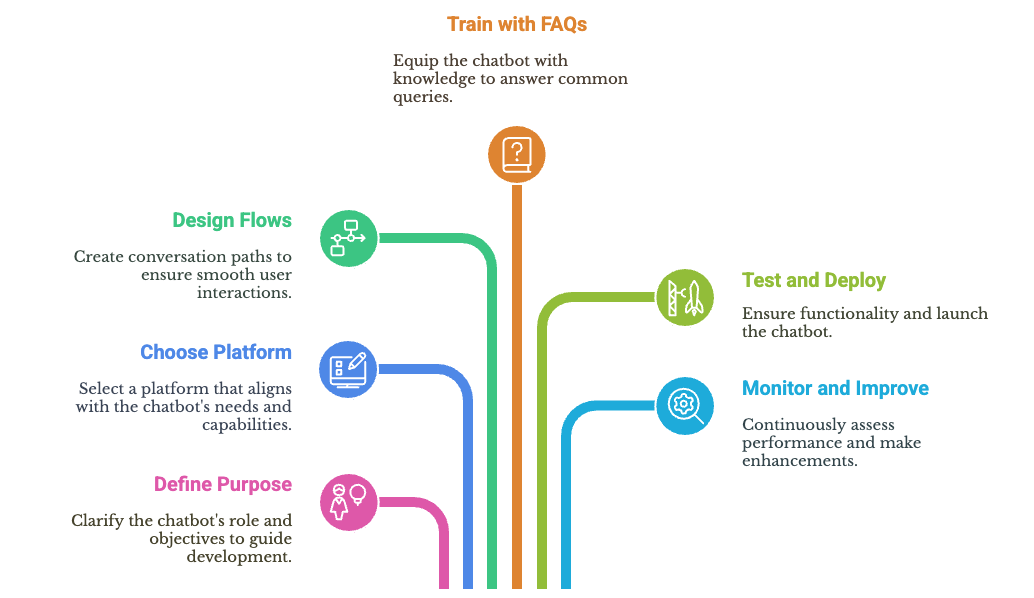
Building a chatbot that actually helps your customers takes more than just picking a platform and hoping for the best. Here's what works — six steps that'll get you from idea to implementation without the usual headaches.
Step 1: Define your chatbot's purpose
Start with the basics: what problems will your bot solve? Look through your support tickets from the past month. What questions keep coming up over and over? Those repetitive queries — password resets, shipping updates, store hours — are perfect chatbot material.
Don't try to build a bot that does everything on day one. Pick three to five common requests and nail those first. Your customers will thank you for quick answers to simple questions rather than slow responses to complex ones.
Step 2: Choose the right chatbot platform
Here's what matters when picking your platform:
- Does it play nice with your current tools?
- Can it grow with your business?
- Will it keep customer data secure?
- Can you make it sound like your brand?
- Need multiple languages? Make sure it supports them.
Skip the bells and whistles you won't use. Focus on platforms that handle your must-haves well rather than ones that do everything poorly.
Step 3: Design conversation flows
Think of this like mapping out a helpful conversation. Your bot needs to know where to start, where to go next, and how to wrap things up without leaving people hanging.
Start simple — create paths for your most common questions first. Then add branches for follow-up questions. Remember, real conversations don't always follow scripts, so give people ways to change topics or start over when they need to.
Step 4: Train your chatbot with FAQs
Feed your bot the good stuff from your help center and support docs. But here's the trick — break everything down into bite-sized pieces. Long, complicated answers don't work well for bots or customers.
Take that 500-word help article about returns and turn it into simple, clear steps. Your bot will understand it better, and so will your customers.
Step 5: Test and deploy
Before you let your bot loose on real customers, put it through its paces. Try weird questions, test edge cases, and see what happens when people don't follow the expected path.
Make sure your bot knows when to give up and hand things over to a human. Nobody likes being stuck in a conversation loop with an unhelpful bot.
Step 6: Monitor and improve
Here's the reality — your bot won't be perfect from day one. Check your metrics regularly: How many conversations does it actually resolve? Where do customers get frustrated? What questions stump it completely?
Use those insights to make your bot smarter. Add new responses, fix confusing flows, and keep teaching it based on real customer interactions.
Why customer service chatbots fail
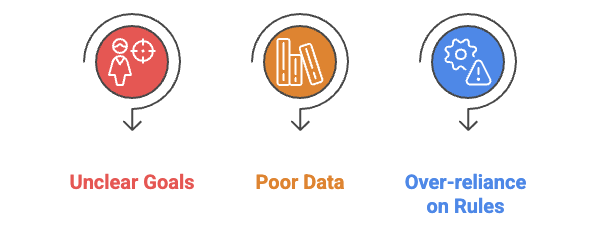
Now that we’ve looked at how to build a customer service chatbot, let’s flip the coin. Because even with the best tools, many still fall flat—and here’s why.
Lack of clear goals or use cases
Most companies build chatbots because they think they should, not because they've figured out what the bot should actually do. Without clear purpose, you end up with a digital assistant that looks fancy but accomplishes nothing useful.
Think of it like this: would you hire a human agent without telling them what their job is? That's exactly what happens when you deploy a chatbot without defining its role.
Here's how to avoid this mess:
- Determine if you truly need a chatbot
- Define its specific role and capabilities
- Focus on solving actual pain points for customers or agents
- Ensure it performs its core functions exceptionally well
A chatbot that does three things really well beats one that tries to do everything poorly. Plus, when you keep your bot's knowledge base current, it can actually handle new issues instead of confusing customers with outdated responses.
Poor training data or outdated knowledge base
Your chatbot is only as good as what you teach it. Feed it garbage data, and it'll give customers garbage answers.
"The process of chatbot training is intricate, requiring a vast and diverse chatbot training dataset to cover the myriad ways users may phrase their questions or express their needs". Most chatbots fail because they're trained on made-up scenarios instead of real customer conversations.
Here's what actually works:
- Regular enrichment of their training datasets
- Integration of actual customer interactions
- Updates reflecting current products, services, and FAQs
- Continuous refinement based on user feedback
Ever ask a chatbot a specific question and get back a link to your entire FAQ page? As one expert puts it, "It is like giving the entire haystack rather than finding and handing over the needle". That's what happens when your bot doesn't have properly structured knowledge.
The numbers don't lie either. During the pandemic, research found that "chatbots ranked last in customer satisfaction among all digital touchpoints, trailing channels like email, text chat or video chat, messaging, cobrowsing, and social media". Poor training data is usually the culprit.
Over-reliance on rule-based logic
Rule-based chatbots work like those old "choose your own adventure" books — follow the script exactly, or you're stuck. The problem? Real conversations don't follow scripts.
"The cost of keeping a rules-based system current and consistent is steep—and these systems are ineffective at handling anything more complex than basic interactions". Customers don't ask questions the way you expect them to, which breaks these rigid systems constantly.
These bots match keywords instead of understanding what people actually want. Someone asks "My order never showed up" and the bot might respond with shipping information because it caught the word "order."
The limitations add up fast:
- Lack of personalization and inability to "remember" users
- Limited ability to adapt to questions outside their scripted responses
- Poor handling of complex issues, leading to frequent escalations
- Exponentially increasing maintenance costs as more rules are added
AI-powered chatbots with Natural Language Understanding work differently. They grasp intent regardless of how someone phrases their question and get better over time without manual updates.
"Larger corporations, offering services beyond simple tasks like parcel tracking, may witness customers frequently resorting to the 'transfer to agent' option, rendering their customer service bot obsolete". That's the reality when your bot can't adapt to real customer needs.
Getting these fundamentals right transforms your chatbot from a customer annoyance into something people actually want to use. Fix these core issues, and both your customers and support team will thank you.
Fixing your chatbot: 6 proven strategies
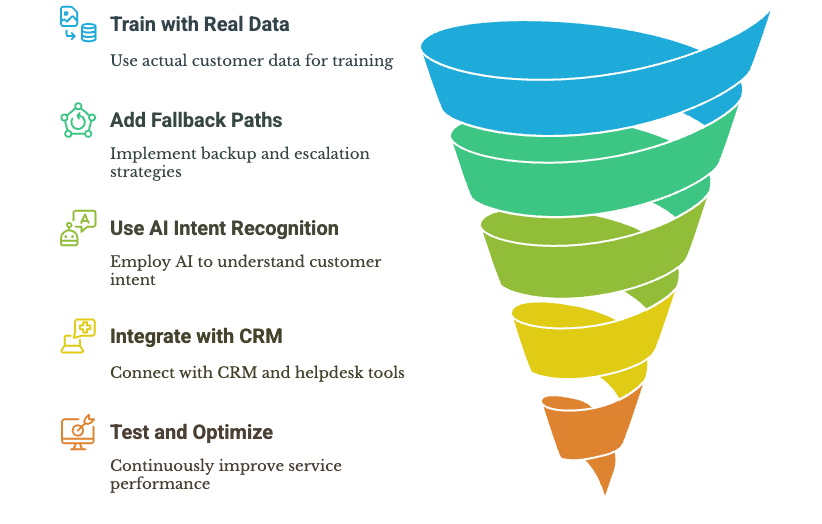
Now that you know what's broken, here's how to fix it. These six strategies will turn your frustrating chatbot into something customers actually want to use.
1. Train with real customer data
Your chatbot is only as good as what you teach it. Stop feeding it made-up scenarios and start using actual conversations from your support tickets, chat logs, and customer emails.
Think of it like this: if you wanted to learn Spanish, would you rather practice with a textbook or have real conversations with native speakers? Your chatbot needs that same authentic exposure to develop fluency.
Here's what works:
- Start with 50-100 real customer queries and their answers
- Focus on variety over quantity
- Include all the different ways customers ask the same question
- Use successful past interactions to boost accuracy by 15-25% over six months
2. Add fallback and escalation paths
No chatbot handles everything perfectly. The trick is failing gracefully when it hits its limits. Proper escalation can actually turn a frustrating experience into a positive one.
Set up clear handoff protocols that include:
- Sentiment analysis to catch frustrated customers early
- Information collection before transfer (so customers don't repeat themselves)
- Conversation history passed to agents
- Positive framing like "I'm connecting you with our VIP agent"
That last point matters more than you'd think. Companies report major satisfaction improvements just by calling transferred customers "VIP" rather than admitting the bot failed. A smooth handoff without losing context makes customers feel heard rather than shuffled around.
3. Use AI-powered intent recognition
Modern chatbots don't just match keywords — they understand what customers actually want. LivePerson's NLU engine detects intent in real-time, helping determine the best conversation flow.
Intent recognition works through:
- Data collection from diverse customer queries
- Feature extraction of keywords and context
- Model training on annotated data
- Intent classification to match inputs to predefined intents
- Response generation based on recognized intent
The best platforms train on over a billion conversations, which lets them automatically recognize up to 65% of intents with minimal setup. That's why AI-powered bots feel so much more natural than their rule-based cousins.
4. Integrate with CRM and helpdesk tools
A chatbot without system integration is like having a receptionist who can't access your files. Businesses with integrated CRM chatbots see up to 70% fewer tickets requiring human agents.
Connected chatbots can:
- Access customer history for personalized responses
- Update CRM records automatically
- Pull relevant knowledge base articles
- Create support tickets for complex issues
5. Continuously test and optimize
Launching your chatbot isn't the finish line. Continuous testing keeps performance high and catches problems before customers do.
Focus on these testing areas:
- Functional testing — Does it give accurate information?
- Security testing — Is customer data protected?
- Regression testing — Do updates break existing features?
- Humanification testing — Does it understand natural language variations?
Track metrics like accuracy, completion rates, and escalation frequency. Test with diverse scenarios that cover different user inputs and edge cases.
6. Update content regularly
Outdated information kills chatbot credibility fast. Regular content updates keep your bot current and relevant.
Create an update schedule:
- Monthly: Add new FAQs for emerging questions
- Quarterly: Review feedback patterns and adjust training
- Bi-annually: Overhaul your entire knowledge base
Build feedback loops with your content team so new products, messaging, or policies get added to the bot immediately. Monthly check-ins with stakeholders help catch content gaps before customers do.
Remember — chatbot development isn't "set and forget." It needs consistent attention through regular feedback loops to improve accuracy and fix conversation flow issues. But get this right, and you'll have a support tool that actually helps instead of frustrates.
3 Best practices for chatbot design
Getting your chatbot design right makes the difference between helpful conversations and frustrated customers. Think of it like this: if your chatbot is having a conversation, it should feel natural — not like reading a manual.
1. Keep conversations short and clear
Nobody wants to read a novel when they're trying to get help. Your chatbot should talk like a helpful person, not a wordy instruction booklet.
Here's what works:
- Break up long responses into smaller chunks (stick to 3-4 message bubbles max)
- One main idea per message
- Get to the point quickly
As IBM puts it, "Word diet: Clear, concise copy reduces friction and demonstrates respect for the user's time". If your bot needs three paragraphs to explain something simple, you're probably overcomplicating it.
2. Use buttons and quick replies
Quick replies are like giving customers a helpful nudge in the right direction. Instead of making them type everything out, you're showing them exactly what options they have.
These little buttons are actually pretty powerful:
- They guide people through conversations without confusion
- No more typos or misunderstood requests
- You can show up to 13 options in most platforms
- Perfect for collecting specific info like email addresses or locations
Just remember — WhatsApp limits you to three options with prompts under 20 characters. For most other platforms, five quick replies tends to work best.
3. Avoid jargon and technical terms
Your customers aren't necessarily experts in your industry. What seems obvious to you might be completely foreign to them.
"Ensuring that your chatbot communicates clearly requires avoiding terms that might not be familiar to all users". Use words your grandmother would understand, especially when you're serving people with different backgrounds and technical knowledge.
Real personalization isn't just using someone's name — it's talking to them in a way that makes sense for who they are and what they know about your business.
10 Customer service chatbot tools worth using
1. SparrowDesk
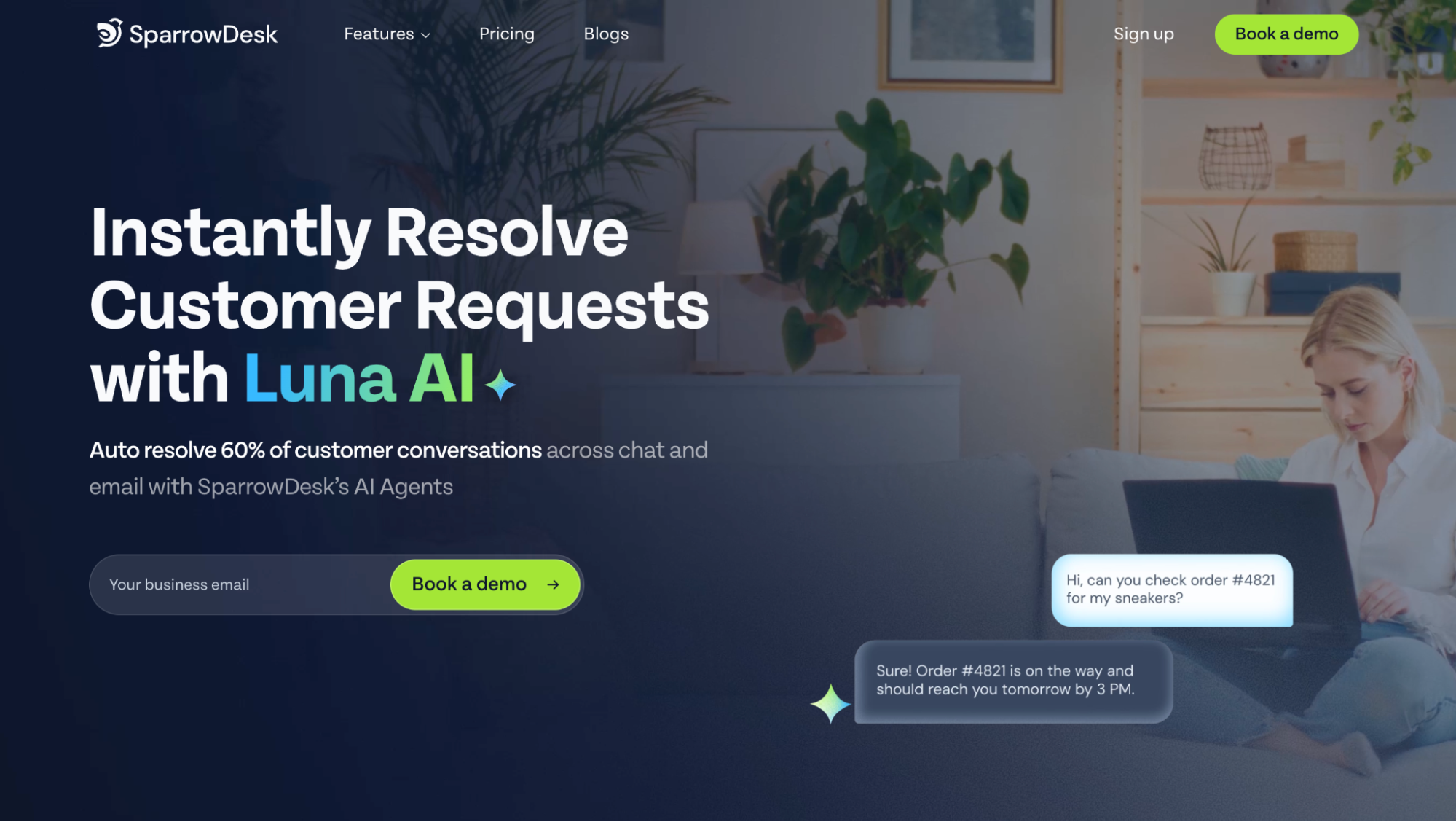
SparrowDesk’s customer service chatbot auto-resolves up to 60% of routine queries through smart automation and personalized answers. It pulls from multiple knowledge sources, adapts to your brand’s tone, and hands off smoothly to human agents when needed. With real-time translations and built-in workflows, it delivers fast, context-aware support across languages and channels.
14-day free trial • Cancel Anytime • No Credit Card Required • No Strings Attached
2.Intercom
Intercom’s chatbot feels sleek. The UI is clean, and the bot actually holds up in real conversations. It handles FAQs, routes to agents, and works across your site, product, and emails. The downside? It gets expensive fast.
3. Zendesk AI
Zendesk has been around forever, and now it has AI baked in. The chatbot is solid—auto-suggests help articles, tags tickets smartly, and even triages issues before routing them. It works if you’re already using Zendesk.
4. Tidio
Tidio is great for smaller teams or ecommerce stores. It’s plug-and-play, has a visual flow builder, and connects easily to Shopify or WordPress. The chatbot isn’t trying to be GPT-level smart—but it handles FAQs and order status just fine.
5. Freshchat (by Freshworks)
Freshchat doesn’t make a lot of noise, but it quietly gets things done. The customer service chatbot works across channels like Instagram, WhatsApp, and your site. You can set up flows without code, and it integrates well with Freshdesk if you use that.
6. Ada
Ada’s whole pitch is “zero-agent resolution,” and honestly, it lives up to it. Their chatbot is no-code, enterprise-grade, and can handle entire support flows without touching a human. Pricey—but worth it if you get hundreds of tickets an hour.
7. Drift
Drift isn’t just a support chatbot—it’s also a lead gen machine. Their customer service chatbot is proactive, knows how to qualify users, and can handle support questions while booking demos. But it’s built more for B2B than retail.
8. LivePerson
LivePerson is what big banks and telecom giants use. Its chatbot is loaded with NLP and intent detection and can handle voice, chat, and messaging platforms. But it’s overkill if you’re not an enterprise.
9. Botpress
Want to build your own AI? Botpress is open-source, flexible, and lets you create a fully custom customer service chatbot. The tradeoff? You need engineers. Lots of them.
10. HubSpot Chatbot Builder
Not amazing, not terrible. If you’re already using HubSpot for CRM or marketing, the chatbot helps route leads, answer simple questions, and qualify support requests. It’s not AI-heavy, but for basic needs, it works.
Final thoughts:
So, we started by exploring what customer service chatbots really are and why they matter today. Then we broke down the different types and benefits they bring to the table — from cutting costs to speeding up responses. After that, we dug into how to build a chatbot that actually works, and just as importantly, why so many fail despite good intentions.
But failure isn’t the end of the road. We looked at six proven strategies to fix those common issues and shared best practices to make sure your chatbot delivers real value. Along the way, we also checked out examples and the best tools available to help you get started or level up.
At the core of it all, customer service chatbots are about balance — combining smart automation with a human touch that keeps customers happy and your team efficient. When built thoughtfully, they become a powerful part of your support system, helping you stay responsive, reduce workload, and deliver better experiences around the clock.
So whether you’re just kicking off your chatbot journey or refining what you’ve got, remember: success comes from understanding your customers, being ready to learn, and never settling for “just okay.” That’s how you build a chatbot that truly supports your business — today and in the future.
Quick summary: Customer service chatbot: The complete guide to building better support
The "Hi! How can I help you today?" message popping up on websites isn't from a human anymore—it's a customer service chatbot quietly transforming how companies handle support. As AI evolves rapidly, the question isn't whether chatbots can handle customer service, but whether they should be the future of scalable support.
- Types & Benefits: From rule-based to AI-powered hybrid models, chatbots offer 24/7 availability, reduced costs, faster response times, and improved customer satisfaction
- Implementation Strategy: Six-step process covering purpose definition, platform selection, conversation flow design, FAQ training, testing, and continuous improvement
- Common Failures: Lack of clear goals, poor training data, and over-reliance on rule-based logic cause most chatbot failures
- Proven Solutions: Six strategies including real customer data training, fallback paths, AI-powered intent recognition, and regular content updates
Success with a customer service chatbot comes from understanding customers, continuous learning, and balancing smart automation with human touch. When built thoughtfully, chatbots become powerful support tools that keep businesses responsive while reducing workload and delivering better experiences around the clock.
Frequently Asked Questions
Training involves feeding it FAQs, linking it to your knowledge base, testing responses, and updating it regularly based on real conversations.
Yes. Many modern customer service platforms offer omnichannel chatbot support, so conversations flow across channels.
A good chatbot is programmed to detect when it reaches its limit—whether due to complexity or customer frustration—and can smoothly transfer the conversation to a live agent without interrupting the user experience.
Absolutely! Many customer service chatbots are built to offer multilingual support, allowing businesses to serve global customers in their preferred languages, with real-time translation features.
Common challenges include ensuring accurate responses, preventing frustrating user experiences, and managing the balance between automation and human support. Proper training, clear escalation paths, and continuous improvement can address these issues.
